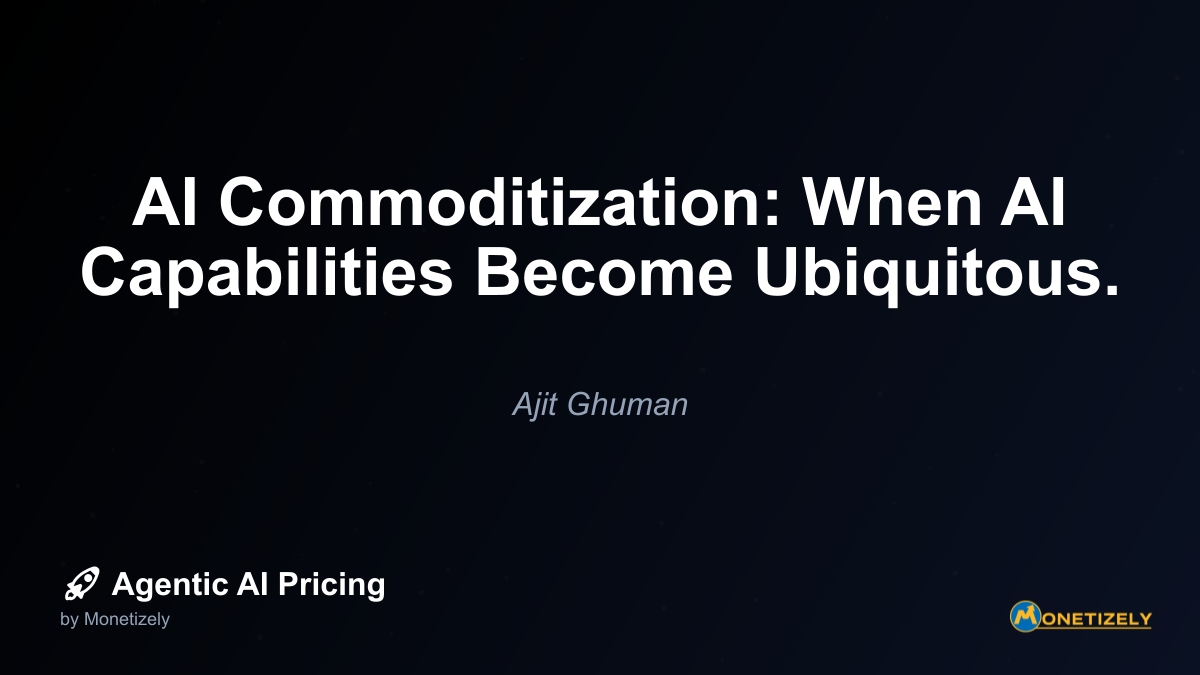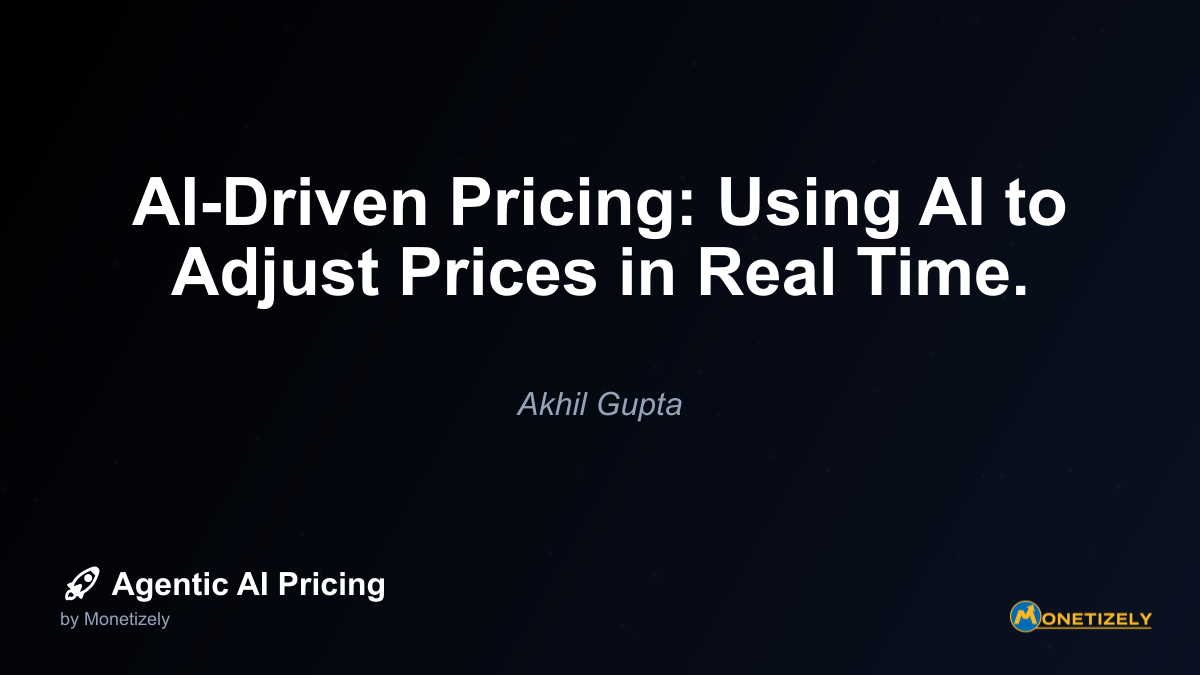· Ajit Ghuman · Emerging Trends · 8 min read
Subscription Fatigue: Are Usage Models the Remedy?
AI and SaaS Pricing Masterclass
Learn the art of strategic pricing directly from industry experts. Our comprehensive course provides frameworks and methodologies for optimizing your pricing strategy in the evolving AI landscape. Earn a professional certification that can be imported directly to your LinkedIn profile.

Usage-based pricing models offer several compelling benefits that directly address the core frustrations of subscription fatigue:
1. Value Alignment
Perhaps the most significant advantage is the direct correlation between cost and value received. Customers only pay when they actively use a service, creating a natural alignment between expense and benefit. This alignment reduces the cognitive dissonance many feel when paying for underutilized subscriptions.
2. Cost Control and Flexibility
Usage models put spending control back in customers’ hands. During periods of lower usage or budget constraints, costs automatically decrease without requiring cancellation decisions or commitment changes. This flexibility is particularly appealing during economic uncertainty.
3. Risk Reduction for New Adoption
For new services, usage-based pricing significantly lowers the adoption barrier. Without upfront commitments or recurring charges, customers can experiment with minimal financial risk—a powerful antidote to the hesitation many feel when considering yet another subscription.
4. Transparency and Trust
Usage pricing creates a more transparent relationship between provider and customer. The implicit message—“we only get paid when we deliver value”—builds trust in a marketplace where consumers increasingly question whether subscription services truly earn their recurring fees.
5. Scalability for Growing Needs
For businesses utilizing services, usage models allow costs to scale proportionally with growth. Small organizations pay for small usage, while enterprise-level consumption commands enterprise-level fees—without requiring renegotiation of subscription tiers.
The Particular Appeal for AI Services
The agentic AI sector stands to benefit uniquely from usage-based pricing models. Several factors make this pricing approach particularly well-suited for AI services:
Variable Value Delivery
AI services often deliver inconsistent value based on the specific use case, quality of inputs, and desired outcomes. Usage pricing acknowledges this variability rather than pretending all interactions have equal worth.
Unpredictable Utilization Patterns
Many AI applications see sporadic usage spikes rather than steady consumption. Pay-as-you-go models accommodate these natural patterns without penalizing customers during low-usage periods.
Demonstrable ROI Connection
Usage-based pricing creates a clearer connection between AI expenditure and business outcomes, making ROI calculations more straightforward and defensible within organizations.
Computational Resource Alignment
The actual costs of providing AI services often correlate directly with usage (compute resources, infrastructure scaling). Usage pricing passes this economic reality transparently to customers.
As implementation approaches for usage-based pricing in AI continue to evolve, early adopters are finding that these models not only alleviate subscription fatigue but actually accelerate adoption by removing the commitment barriers that subscriptions erect.
Real-World Success Stories: Usage Models in Action
Several companies across different sectors have successfully implemented usage-based pricing to address subscription fatigue:
Twilio: The communications API provider pioneered usage-based pricing in the developer tools space, charging only for messages sent or minutes used. This approach helped them achieve massive scale by removing adoption barriers for developers.
AWS: Amazon Web Services’ pay-as-you-go model revolutionized how businesses consume computing resources, eliminating the need for massive capital expenditures and allowing for precise matching of costs to actual needs.
Snowflake: The data warehouse company implements a consumption model based on actual compute resources used, allowing customers to scale costs directly with value received.
OpenAI: With its token-based pricing for API access, OpenAI has made advanced AI capabilities accessible without subscription commitments, accelerating adoption across countless use cases.
The common thread among these success stories is the liberation from fixed recurring costs, replacing them with variable expenses that reflect actual value delivery—precisely the remedy that fatigued consumers seek.
Challenges in Transitioning to Usage-Based Models
Despite their appeal, usage-based models aren’t without implementation challenges:
Revenue Predictability
For businesses, the shift from predictable subscription revenue to variable usage-based income introduces forecasting complexity. This unpredictability can affect everything from cash flow management to investor relations.
Customer Education
Many customers are conditioned to evaluate subscription costs, not usage metrics. Educating users on how to assess value and predict expenses under usage models requires thoughtful communication.
Pricing Complexity
Determining the right usage metrics and rates involves complex analysis of cost structures, value delivery, and competitive positioning—often more challenging than setting simple subscription tiers.
Billing Infrastructure
The technical requirements for tracking usage, calculating charges, and processing variable payments exceed those of subscription systems, requiring specialized infrastructure.
Psychological Barriers
Some customers prefer the certainty of fixed costs over the potential variability of usage pricing, even if the latter might save them money overall.
Organizations considering the shift must carefully weigh these challenges against the potential benefits of addressing subscription fatigue through usage-based alternatives.
Hybrid Approaches: The Best of Both Worlds?
Many successful companies are finding that hybrid models—combining elements of subscriptions with usage-based components—offer a balanced approach to addressing subscription fatigue while preserving business stability.
Common hybrid approaches include:
Base subscription + usage: A lower fixed fee provides basic access, with additional charges based on consumption beyond included thresholds
Committed use discounts: Usage-based pricing with discounts for pre-committed usage levels, providing customers cost certainty while preserving the usage connection
Credit-based systems: Subscription purchases credits that are consumed through usage, creating budget predictability while maintaining the usage-value connection
Freemium with usage pricing: Free basic access with pay-as-you-go pricing for premium features or higher usage levels
These hybrid models can serve as transitional approaches for both businesses and customers adapting to new pricing paradigms in the wake of subscription fatigue.
The Future of Pricing: Beyond Binary Models
As the market responds to subscription fatigue, we’re likely to see continued innovation in pricing models that transcend the simple subscription versus usage-based dichotomy. Emerging approaches include:
Outcome-based pricing: Charging based on measurable business results rather than inputs or usage
Value-metric pricing: Identifying and charging based on the specific metrics that correlate most directly with customer-perceived value
Community pricing: Models that adjust pricing based on collective usage patterns across customer communities
AI-optimized dynamic pricing: Using artificial intelligence to continuously adjust pricing based on usage patterns, customer segments, and value delivery
These evolving approaches suggest that the remedy for subscription fatigue isn’t simply replacing one rigid model with another, but rather creating more flexible, value-aligned pricing systems that respect the diversity of customer needs and usage patterns.
Strategic Considerations for Businesses
For organizations considering a shift toward usage-based pricing to address subscription fatigue, several strategic questions deserve careful consideration:
1. Value Metric Identification
What measurable aspect of your service most directly correlates with customer-perceived value? The most successful usage-based models charge based on metrics that customers intuitively connect to value received.
2. Customer Segmentation Analysis
How do usage patterns vary across different customer segments? Understanding these differences helps design usage pricing that works for diverse customer types rather than optimizing for an “average” that may not exist.
3. Revenue Impact Modeling
What would the revenue impact be under various usage scenarios? Thorough financial modeling helps identify potential risks and opportunities before committing to model changes.
4. Competitive Positioning
How will usage-based pricing affect your competitive positioning? In markets where subscriptions dominate, usage models can serve as powerful differentiators—or potential confusion points.
5. Infrastructure Requirements
What technical capabilities are needed to implement, track, and bill for usage? The operational requirements for usage-based pricing often exceed those for subscription models.
6. Communication Strategy
How will you explain the value proposition of usage-based pricing to subscription-fatigued customers? Effective messaging can position usage pricing as the remedy customers have been seeking.
Practical Implementation Steps
For businesses ready to explore usage-based pricing as a remedy for subscription fatigue, these practical steps provide a roadmap:
Conduct usage pattern analysis across your current customer base to understand consumption behaviors
Identify candidate value metrics that correlate strongly with customer outcomes
Model financial impacts under various usage scenarios and pricing structures
Develop the necessary tracking infrastructure to measure and report on usage accurately
Create clear, transparent pricing communications that help customers understand and predict costs
Consider piloting usage-based options alongside existing subscription offerings to test market reception
Gather feedback continuously and be prepared to iterate on the model based on customer response
Train customer-facing teams to explain the benefits of usage pricing in addressing subscription concerns
This methodical approach helps organizations transition thoughtfully toward pricing models that alleviate rather than contribute to subscription fatigue.
Conclusion: Finding Balance in the Subscription Economy
Subscription fatigue represents a natural market response to the proliferation of recurring payment models across every aspect of consumer and business life. As customers become more selective and critical of their recurring financial commitments, businesses must adapt with pricing approaches that better align with actual value delivery and usage patterns.
Usage-based and consumption models offer promising remedies to this fatigue by fundamentally changing the value proposition: pay only when you receive value, rather than paying continuously regardless of usage. This alignment creates a healthier, more sustainable relationship between service providers and their customers.
For agentic AI services in particular, usage-based pricing models present a compelling opportunity to accelerate adoption by removing the commitment barriers that subscriptions create. By charging based on actual utilization rather than access rights, AI providers can make their services more accessible while still capturing appropriate value from heavy users.
The future likely belongs not to pure subscription or pure usage models, but to thoughtfully designed hybrid approaches that balance the predictability businesses need with the flexibility and value alignment that customers increasingly demand. Organizations that navigate this transition successfully will find themselves well-positioned to thrive in a market where subscription fatigue has become a defining consumer sentiment.
As we move forward, the most successful pricing strategies will be those that recognize a fundamental truth: customers don’t inherently dislike paying for value—they dislike paying when no value is received. Usage-based pricing models embrace this principle, offering a path toward more sustainable customer relationships in an increasingly crowded digital marketplace.
Co-Founder & CEO
Ajit is the author of Price To Scale, a top book on SaaS Pricing and is the Founder of Monetizely. Ajit has led and worked in pricing and product marketing at firms like Twilio, Narvar and Medallia. His work has been featured in Forbes and VentureBeat. Ajit regularly consults with software companies from Seed stage to post-IPO on pricing strategy. Ajit is also a highly-rated co-instructor for 'The Art of SaaS Pricing and Monetization' on Maven.
Pricing Strategy Audit
Let our experts analyze your current pricing strategy and identify opportunities for improvement. Our data-driven assessment will help you unlock untapped revenue potential and optimize your AI pricing approach.




